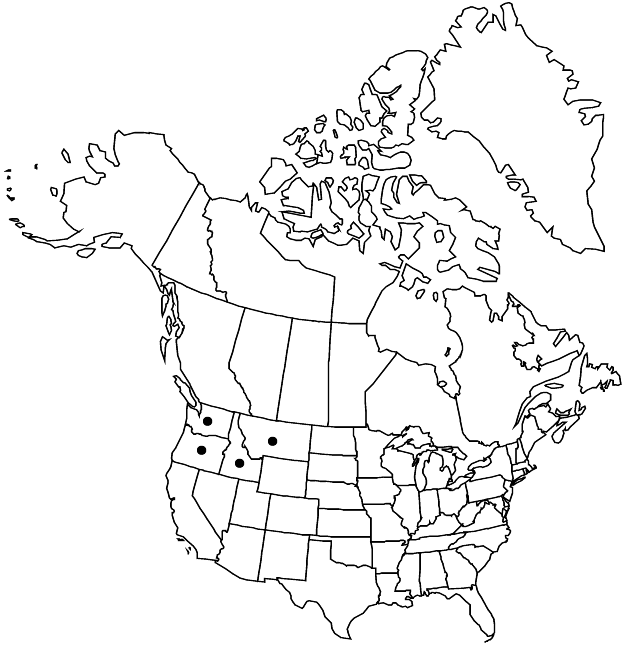Difference between revisions of "Micranthes idahoensis"
J. Bot. Res. Inst. Texas 1: 1020. 2007 ,.
FNA>Volume Importer |
imported>Volume Importer |
||
| (6 intermediate revisions by 2 users not shown) | |||
| Line 7: | Line 7: | ||
}} | }} | ||
|common_names=Idaho saxifrage | |common_names=Idaho saxifrage | ||
| − | |basionyms={{Treatment/ID/ | + | |basionyms={{Treatment/ID/Basionym |
|name=Saxifraga idahoensis | |name=Saxifraga idahoensis | ||
|authority=Piper | |authority=Piper | ||
| + | |rank=species | ||
| + | |publication_title=Bull. Torrey Bot. Club | ||
| + | |publication_place=27: 394. 1900 | ||
}} | }} | ||
|synonyms={{Treatment/ID/Synonym | |synonyms={{Treatment/ID/Synonym | ||
|name=Saxifraga marshallii subsp. idahoensis | |name=Saxifraga marshallii subsp. idahoensis | ||
|authority=(Piper) D. L. Krause & Beamish | |authority=(Piper) D. L. Krause & Beamish | ||
| − | }}{{Treatment/ID/Synonym | + | |rank=subspecies |
| + | }} {{Treatment/ID/Synonym | ||
|name=Saxifraga marshallii var. idahoensis | |name=Saxifraga marshallii var. idahoensis | ||
|authority=(Piper) Engler & Irmscher | |authority=(Piper) Engler & Irmscher | ||
| − | }}{{Treatment/ID/Synonym | + | |rank=variety |
| + | }} {{Treatment/ID/Synonym | ||
|name=Saxifraga occidentalis var. idahoensis | |name=Saxifraga occidentalis var. idahoensis | ||
|authority=(Piper) C. L. Hitchcock | |authority=(Piper) C. L. Hitchcock | ||
| + | |rank=variety | ||
}} | }} | ||
|hierarchy=Saxifragaceae;Micranthes;Micranthes idahoensis | |hierarchy=Saxifragaceae;Micranthes;Micranthes idahoensis | ||
| Line 35: | Line 41: | ||
|elevation=500-2500 m | |elevation=500-2500 m | ||
|distribution=Idaho;Mont.;Oreg.;Wash. | |distribution=Idaho;Mont.;Oreg.;Wash. | ||
| − | |discussion=<p>Micranthes idahoensis appears to hybridize with M. occidentalis where their ranges overlap. Intermediates are abundant in some populations along the Idaho-Montana border and in Montana. This phenomenon may explain the range of filament shapes found in M. occidentalis, from flattened to sightly club-shaped. The issue of the status of M. idahoensis with respect to M. marshallii (D. L. Krause and K. I. Beamish 1972) is best deferred until a thorough study of the whole complex over its entire range is done.</p> | + | |discussion=<p><i>Micranthes idahoensis</i> appears to hybridize with <i>M. occidentalis</i> where their ranges overlap. Intermediates are abundant in some populations along the Idaho-Montana border and in Montana. This phenomenon may explain the range of filament shapes found in <i>M. occidentalis</i>, from flattened to sightly club-shaped. The issue of the status of <i>M. idahoensis</i> with respect to <i>M. marshallii</i> (D. L. Krause and K. I. Beamish 1972) is best deferred until a thorough study of the whole complex over its entire range is done.</p> |
|tables= | |tables= | ||
|references= | |references= | ||
| Line 44: | Line 50: | ||
-->{{#Taxon: | -->{{#Taxon: | ||
name=Micranthes idahoensis | name=Micranthes idahoensis | ||
| − | |||
|authority=(Piper) Brouillet & Gornall | |authority=(Piper) Brouillet & Gornall | ||
|rank=species | |rank=species | ||
| Line 59: | Line 64: | ||
|publication year= | |publication year= | ||
|special status= | |special status= | ||
| − | |source xml=https:// | + | |source xml=https://bitbucket.org/aafc-mbb/fna-data-curation/src/2e0870ddd59836b60bcf96646a41e87ea5a5943a/coarse_grained_fna_xml/V8/V8_120.xml |
|genus=Micranthes | |genus=Micranthes | ||
|species=Micranthes idahoensis | |species=Micranthes idahoensis | ||
Latest revision as of 22:41, 5 November 2020
Plants solitary or tufted, with bulbils on caudices. Leaves basal; petiole flattened, 1–5 cm; blade ovate to elliptic, 1–4 cm, ± fleshy, base attenuate, margins shallowly serrate to dentate (teeth usually to 1 mm), sparsely ciliate, surfaces tangled, reddish brown-hairy abaxially, glabrate adaxially. Inflorescences 15+-flowered, open thyrses, (flowers ± crowded at tips, becoming more open in fruit), 10–40 cm, purple-tipped stipitate-glandular. Flowers: sepals reflexed, ovate to oblong; petals white, with 2 basal yellow spots (often faded when dried), elliptic to ovate, clawed to nearly not clawed, 1–3.5 mm, ± equaling sepals; filaments club-shaped, not petaloid, (equaling petals); pistils distinct almost to base; ovary superior, (to 1/3 adnate to hypanthium). Capsules green to reddish purple, folliclelike. 2n = 20.
Phenology: Flowering spring–early summer.
Habitat: Open ledges and slopes
Elevation: 500-2500 m
Distribution

Idaho, Mont., Oreg., Wash.
Discussion
Micranthes idahoensis appears to hybridize with M. occidentalis where their ranges overlap. Intermediates are abundant in some populations along the Idaho-Montana border and in Montana. This phenomenon may explain the range of filament shapes found in M. occidentalis, from flattened to sightly club-shaped. The issue of the status of M. idahoensis with respect to M. marshallii (D. L. Krause and K. I. Beamish 1972) is best deferred until a thorough study of the whole complex over its entire range is done.
Selected References
None.
